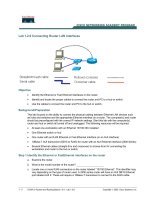1 2 6 bees and flowers (nonfiction)
Bạn đang xem bản rút gọn của tài liệu. Xem và tải ngay bản đầy đủ của tài liệu tại đây (35.35 KB, 2 trang )
Bees and Flowers
by Pedro Valdez
ELL Reader 1.2.6
Nonfiction
INTRODUCE THE BOOK
RESPOND
Activate Prior Knowledge/Build
Background Read the title, and ask children
what they know about bees. Ask: Have you ever
seen a bee? Where was it? What was it doing?
Tell children this book tells how bees and flowers
help each other.
Answers to the Reader’s Inside Back Cover:
Preview/Use Text Features Preview the
reader by talking about the photographs together
and naming the labeled items.
Write About It
3. Encourage children to refer back to the story.
They should draw and write about the part of the
story they liked best. Possible response: I liked
when the bee ate nectar.
Support writers at various English proficiency
levels.
Beginning Provide this sentence frame:
I liked when the bee ___. Have children dictate
an ending.
Intermediate Provide the same sentence
frame, but have children write the whole
sentence.
Advanced Have children write a sentence to
say why they liked that part of the book best.
Preteach Vocabulary Review the tested
vocabulary words that appear in this book:
some (p. 5) and also (p. 7). Introduce these
key words from the book: bees (p.1), flowers
(p. 1), nectar (p. 2), and honey (p. 2). Discuss
these words and add them to a Word Wall.
READ THE BOOK
Choose among these options for reading to
support children at all English proficiency levels.
Read Aloud Read the book aloud as children
follow along. Pause to verify comprehension and
to explain unfamiliar concepts.
Monitored Reading Have children read
aloud a few pages at a time. Use the following
questions to support comprehension:
• Page 2 Where do bees live? (Bees live in
hives.)
• Page 3 What do bees eat? (Bees eat
nectar.)
• Pages 4–5 Why do flowers need bees?
(Bees carry pollen to flowers.)
• Page 6 What do bees make? (Bees make
honey.)
• Page 7 Where is the hive? (The hive is in
the garden.)
• Page 8 What is in the picture? (a bee)
Talk About It
1. Bees need nectar to make honey. (Draw
Conclusions)
2. Honey is sweet and golden brown.
Extend Language A person who takes care of
a zoo and the animals in it is a zookeeper. Ask
children what you call a person who takes care
of a house and everything in it (housekeeper).
Answers to page 24:
Suggest that children look back at the book
for words or sentences they can write. Possible
responses: First: Bees eat nectar.
Next: Bees carry pollen from flower to flower.
Last: Bees make honey.
Family Link Read aloud the Family Link activity
on page 24 before sending copies of the Study
Guide home with children. Later, have them tell
about family members’ experiences seeing how
bees and flowers help each other.
© Scott Foresman 1
Reread Have children reread the book with a
partner, in small groups, or independently. Have
them complete the Study Guide on page 24.
ELL Readers Teaching Guide
Unit 2, Week 6 Bees and Flowers
23
Study Guide
Bees and Flowers
Name
• Read Bees and Flowers again.
• Draw pictures to show what bees do first, next,
and last. Write words or sentences to go with your
pictures.
First (page 3)
Next (page 5)
Family Link
Ask family members to tell about seeing how bees
and flowers help each other.
24
Bees and Flowers Unit 2, Week 6
ELL Readers Teaching Guide
© Scott Foresman 1
Last (page 6)









